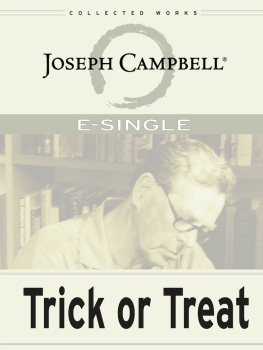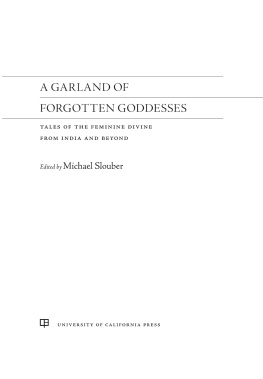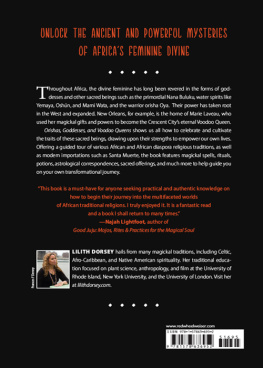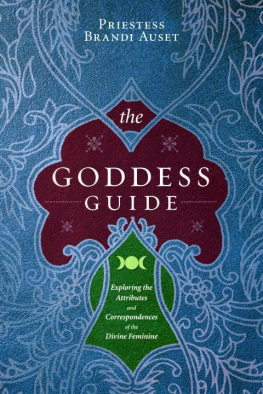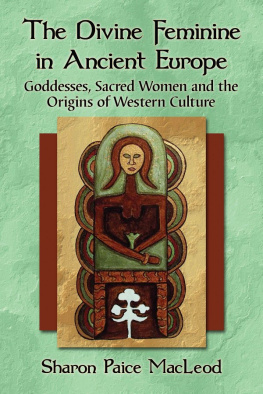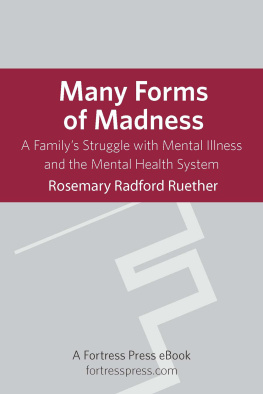Ruether - Goddesses and the divine feminine: a Western religious history
Here you can read online Ruether - Goddesses and the divine feminine: a Western religious history full text of the book (entire story) in english for free. Download pdf and epub, get meaning, cover and reviews about this ebook. City: Berkeley;Calif, year: 2005, publisher: University of California Press, genre: Religion. Description of the work, (preface) as well as reviews are available. Best literature library LitArk.com created for fans of good reading and offers a wide selection of genres:
Romance novel
Science fiction
Adventure
Detective
Science
History
Home and family
Prose
Art
Politics
Computer
Non-fiction
Religion
Business
Children
Humor
Choose a favorite category and find really read worthwhile books. Enjoy immersion in the world of imagination, feel the emotions of the characters or learn something new for yourself, make an fascinating discovery.
- Book:Goddesses and the divine feminine: a Western religious history
- Author:
- Publisher:University of California Press
- Genre:
- Year:2005
- City:Berkeley;Calif
- Rating:3 / 5
- Favourites:Add to favourites
- Your mark:
- 60
- 1
- 2
- 3
- 4
- 5
Goddesses and the divine feminine: a Western religious history: summary, description and annotation
We offer to read an annotation, description, summary or preface (depends on what the author of the book "Goddesses and the divine feminine: a Western religious history" wrote himself). If you haven't found the necessary information about the book — write in the comments, we will try to find it.
Ruether: author's other books
Who wrote Goddesses and the divine feminine: a Western religious history? Find out the surname, the name of the author of the book and a list of all author's works by series.
Goddesses and the divine feminine: a Western religious history — read online for free the complete book (whole text) full work
Below is the text of the book, divided by pages. System saving the place of the last page read, allows you to conveniently read the book "Goddesses and the divine feminine: a Western religious history" online for free, without having to search again every time where you left off. Put a bookmark, and you can go to the page where you finished reading at any time.
Font size:
Interval:
Bookmark:

University of California Press
Berkeley and Los Angeles, California
University of California Press, Ltd.
London, England
2005 by The Regents of the University of California
The author and publisher have made considerable effort to contact copyright holders and to secure permission prior to publication. Any copyright holder who remains unacknowledged may contact the publisher, who will correct the oversight at the earliest opportunity.
Library of Congress Cataloging-in-Publication Data
Ruether, Rosemary Radford.
Goddesses and the divine feminine : a Western
religious history / Rosemary Radford Ruether.
p. cm.
Includes bibliographical references and index.
ISBN 0-520-23146-5 (alk. paper)
1. Goddesses. 2. Women and religion.
3. Goddess religion. I. Title.
BL325.F4R84 2005
202'.114dc22 2004029226
Manufactured in the United States of America
14 13 12 11 10 09 08 07 06 05
10 9 8 7 6 5 4 3 2 1
The paper used in this publication meets the minimum requirements of ANSI/NISO Z39.481992 (R 1997)
(Permanence of Paper).
I wish to thank many people who have given me critical feedback on this work. This list includes Gale Yee of the Episcopal Divinity School in Cambridge, Massachusetts, and Cheryl Anderson of Garrett-Evangelical in Evanston, Illinois, for reading the chapter on Hebrew scripture; Luise Schottroff of the Pacific School of Religion in Berkeley for reading the section on the New Testament; Margaret Conkey and Carolyn Merchant of the University of California at Berkeley for reading the material on anthropology; David Lawrence of the Swedenborgian Institute at the Pacific School of Religion for reading the section on Swedenborg; Moses Penumaka, doctoral student at the Graduate Theological Union, for his extensive work in scanning and preparing the pictures for the book; and the students in the Spring 2003 course Goddesses and the Spiritual Feminine, for their reflections on what the material in this book means to them.
My interest in goddesses of the ancient Near East and Greece goes back to 1954, when I began studying the religious worldviews of these societies. and various religious movements, such as the mystery religions of the Hellenistic and Greco-Roman worlds, in which Cybele, Isis, and other goddesses were central. It became evident to me that the Hebrew religion and Christianity, far from simply repressing and leaving behind these pagan religious worldviews, had appropriated and reinterpreted them. The Christianity that emerged in the first to fourth century was, in many ways, a reinterpreted synthesis of the religious worldviews of the ancient Mediterranean world.
In studying the Hebrew Bible and early Christianity side by side with ancient paganism, I found myself attracted to the prophetic traditions that sided with the poor and oppressed and denounced the rich and powerful. As I became involved in the civil rights and antiwar movements of the 1960s, this spiritual lineage undergirded my commitment to justice. Although the ancient pagan religions that I had been studying seemed to lack this prophetic social justice tradition, I nevertheless continuedto regard them as offering valid spiritual worldviews, as did my mentors, such as Robert Palmer, who frankly preferred ancient paganism to Christianity.
I began to think in terms of complementary spiritualitiespagan, prophetic, and contemplative. Pagan spirituality, typical of most indigenous religions, focuses on the renewal of the earth and human life within the changing seasons. Prophetic spirituality focuses on the struggle to restore just and harmonious relations among humans and with the earth in a covenantal relation with a creating and redeeming God, over against a world dominated by great systems of oppression and injustice. Contemplative spirituality withdraws from the illusions of transitory existence and seeks to unite the soul with the permanent source of reality.
I saw ancient Judaism building on pagan spirituality and reinterpreting it in the light of a historical and prophetic viewpoint. In the Hellenistic era, Jewish thinkers such as Philo appropriated Neoplatonic thought and used it to develop a mystical hermeneutics and a contemplative practice of Judaism. Christianity also built on and reinterpreted these many layers of spirituality. In its focus on ascetic, monastic life, it emphasized the contemplative path for more than a millennium, but it never lost the seasonal spirituality on which the church year was based. Periodically, prophetic spirituality was recovered in order to struggle against systems of injustice, including those within the church itself. Today, modern ecological movements have rediscovered the spirituality of earth renewal, marrying it to prophetic critique. Thus, each of these spiritualities not only has a distinct validity but also continually interacts with the others in new and creative ways.
In 1968, a feminist critique of male-dominated societies started to emerge in the civil rights movement. In the early sixties, I had already questioned the way Catholicism treated women's sexuality and reproductive role.
In 1972, I was invited to teach for a year at Harvard Divinity School under the Chauncey Stillman Chair of Roman Catholic Studies.the Paleolithic and Neolithic female figures that were said to represent this Mother Goddess.
I was surprised and intrigued when my students, almost all feminist women, were repelled by these images. The large breasts, bellies, and buttocks of these figures, with truncated hands and feet and a head that lacked facial features, struck them as exploitative images of the female. To their minds, the societies that made these images valued women's bodies as a source of sex and nurture but did not value women's person or agency. The students argued that these prehistoric images depicted a woman as all buttocks, breasts, and belly, not as a person with facial features who saw, thought, or spoke, not as a person who moved around on her own two feet and took charge of things with her hands.
Until then, I had assumed that the existence of these ancient female figurines was proof that women had been respected and had wielded power in these ancient matriarchal, or at least prepatriarchal, societies. Later in the 1970s, a new movement of Goddess religion would emerge that would again interpret these ancient figurines as testimony of a positive view of women. For example, Anne Barstow, in her article The Prehistoric Goddess, talks of being thrilled by these images and feeling that, for the first time, her female body had been affirmed.)as evidence of a time when women held leading positions in society and were revered and worshipped as primary exemplars of the divine. But my students' negative reaction to these same images made me aware that both of these responses are projections from our modern context and that neither view may have much to do with what the creators of these images actually had in mind.
Also in the 1970s, I began to read in the emerging field of feminist anthropology, which questioned the entire theory of matriarchal origins and explored the more complex ways in which gender and male-female relations developed in various societies. I also became aware of how much the concept of an original matriarchal society, superseded by patriarchy, was itself a product of nineteenth-century European societies marked by their own acute conflicts between masculine and feminine constructions of genderconflicts that reflected the beginning of the feminist movement and the efforts to marginalize and repress it. In the 1950s and early 1960s, I had encountered this theory of matriarchal origins in the works of classical archaeologists and historians, and I now began to reread these accounts more as products of their own European context and less as reliable accounts of prehistoric antiquity.
Font size:
Interval:
Bookmark:
Similar books «Goddesses and the divine feminine: a Western religious history»
Look at similar books to Goddesses and the divine feminine: a Western religious history. We have selected literature similar in name and meaning in the hope of providing readers with more options to find new, interesting, not yet read works.
Discussion, reviews of the book Goddesses and the divine feminine: a Western religious history and just readers' own opinions. Leave your comments, write what you think about the work, its meaning or the main characters. Specify what exactly you liked and what you didn't like, and why you think so.




